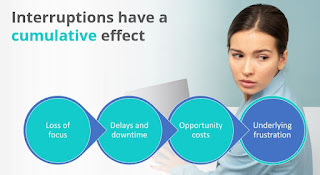The modern workplace has built in delays, interruptions and distractions that have a negative impact on productivity, engagement, and mental health. Companies can improve flow with leadership development and smarter work design. Here's how: youtu.be/FYYoBMgZKnQ
Working Girl
Exploring the Lighter Side of Leadership and Human Capital Management
Friday, June 10, 2022
Friday, May 27, 2022
Things to do with COVID
All in all, it sucked less than pretty much every cold I've ever had, no doubt thanks to vaccinations, but it's a major inconvenience because you're quarantined even if you feel fine. It goes against the grain somehow.
So, there I was holed up in my room for eight days in splendid isolation. Even my kids, who (whom?) I adore but who have needed something from me literally every 90 seconds since being born, left me in peace. What to do with all this enforced downtime?
- Learn to use video editing software - I've been meaning to do this for a while but what with work, kids, etc., haven't gotten around to it. So I made two videos using two different free programs, the Microsoft Video Editor and Animaker. MVE is very basic but only took about 10 seconds to learn. Animaker took a bit longer to assemble all my bits but was also pretty easy. I created this two minute animated short about manager burnout if you'd like to watch it.
- Sort everything - My closet and drawers have never looked this good. Everything has a place. Everything fits. It's magnificent!
- Inventory emergency supplies - No, no, nothing to do with the state of the world. I'm from Los Angeles where we take disaster preparedness very seriously. Sad truth is I've gotten a bit soft living in Germany, where there are no earthquakes, fires or gang wars to keep you living in a state of readiness, but everyone should have basic emergency supplies and an up to date supply manifest. I also sampled several emergency ration bars and so far this one's my favorite because it's light, delicious, and lasts 20 years.
- Catch up on admin and appointments - I hate using the phone because either it's my evening if I'm calling the US, or because my phone German is pretty rough and the other person always sounds judgy. However, when your own family is avoiding you and you can't go anywhere the phone starts to look like a friend. Even admin starts to wear a more appealing face because it's something to do. So I did it.
- Work - Yeah, I did some of that, too.
- Connecting with old friends - There were a lot of people I owed a personal note or update to, so I did that as well. It was nice.
- Peloton - My husband bought a Peloton bike last year over my protests but I LOVE IT!!! Best of all, although I was banned from our home gym, they offer all sorts of bodyweight strength and fitness programs you can do in the privacy of your COVID isolation chamber.
- Beauty treatments - Normally these are tricky because you don't have any privacy in a big family but COVID changes all that. I finally broke out that Laszlo moisture mask I've been saving for a special occasion and wore it for the full 20 minutes without anyone making 'burn victim' jokes. Yes, husband, I mean you!!
- Re-read Agatha Christie - There's just nothing as soothing as the Grand Dame of mystery, specifically Miss Marple. I suppose back in the day these were quite thrilling but nowadays it's just soothing like garlic mashed potatoes for the brain.
- Binge watch Brooklyn 99 - OK, so when my kids started watching this awhile back I thoguht it was the stupidest show I'd ever seen but I kept finding myself laughing out loud each time I walked by. The plot is thin but the dialog is clever and the acting is superb. It is in my humble opinion the perfect binge show.
Thursday, May 26, 2022
Are managers at higher risk of burnout?
Employee experience is essential for business success, but a critical sub-group tends to get less attention than they require. Managers face unique challenges that put them at heightened risk of burnout. Left unattended, companies risk alienating this critical and expensive to replace talent segment.
You can learn more here in this short animated video I created using Animaker: https://youtu.be/2xxdvPrgUec
Sunday, March 13, 2022
Find Your Flow and Avoid Burnout in the Post-Pandemic World of Work
Saturday, July 25, 2020
Resilient HR, Resilient Company
How can HR continue to build its influence and drive strategy in the post-Corona workplace?
Where can I find the answers without reading a long blog post?
https://www.youtube.com/watch?v=CF3jpuQf6TE
Sunday, July 5, 2020
Dare to Share: Building a Courageous Culture
https://youtu.be/28EAAMPPIq0
Wednesday, June 24, 2020
Embracing Diversity and Leading Diverse Teams
Cultural diversity is just one lens on the many different perspectives people bring to the workplace, and like the other lenses can challenge an inflexible leadership style. A manager who clings to his or her comfort zone like a one trick pony will struggle to get the best out of a diverse team.
How do you build and lead a diverse team effectively? By hiring people better than you and helping them play to their strengths while being very clear about your expectations.
If, however, company and team culture are truly inclusive and allow for a high degree personal expression, you might just get… magic. That's why the 'secret sauce' of a successful diversity strategy is inclusion, as Asif Sadiq, Global Head of Diversity and Inclusion, explains in this short interview.
https://www.youtube.com/watch?v=k0YsI1Labho









